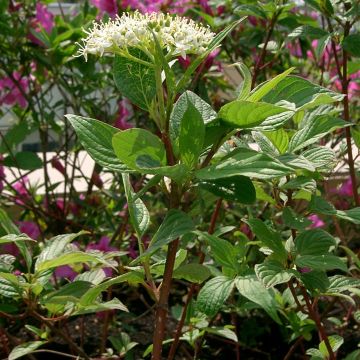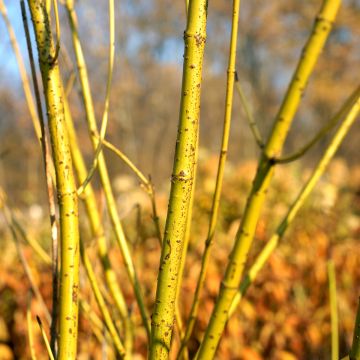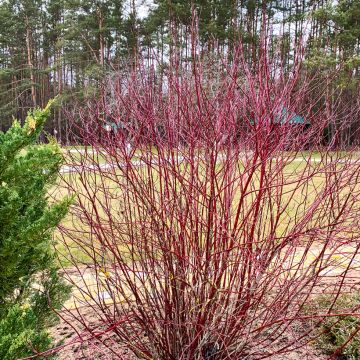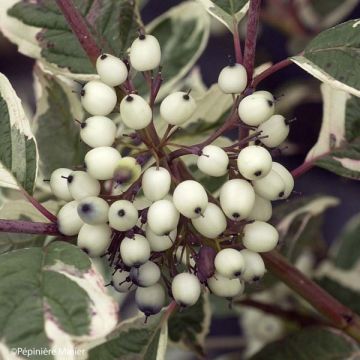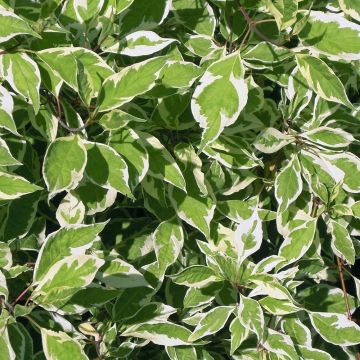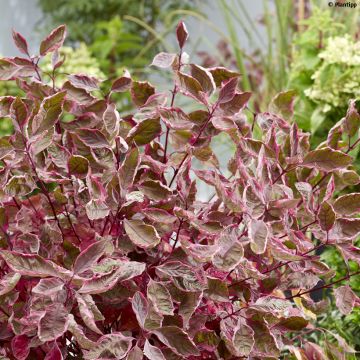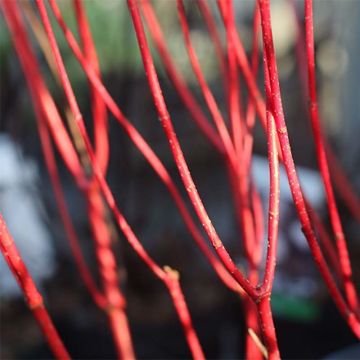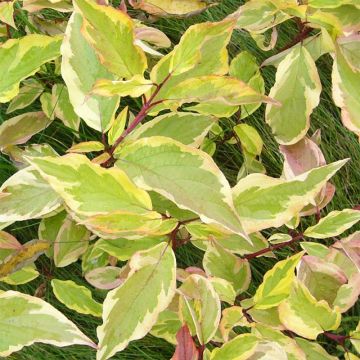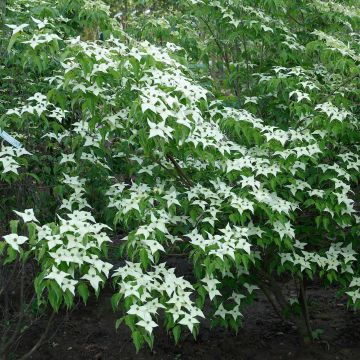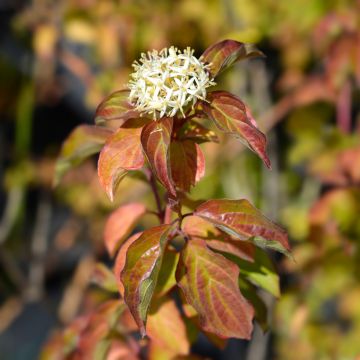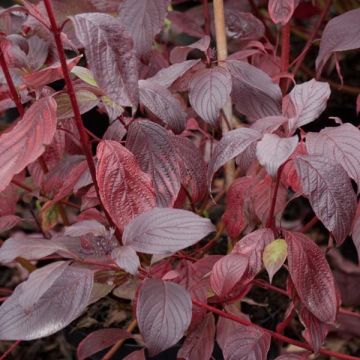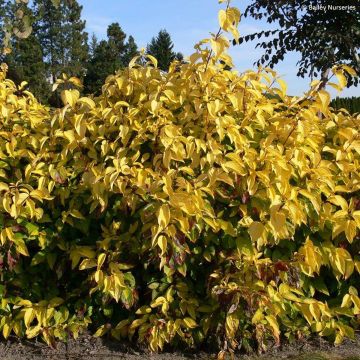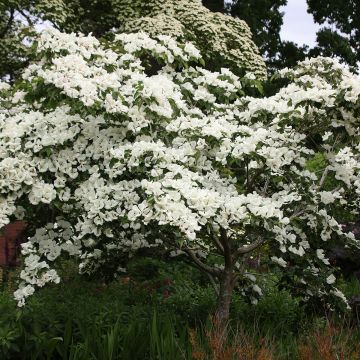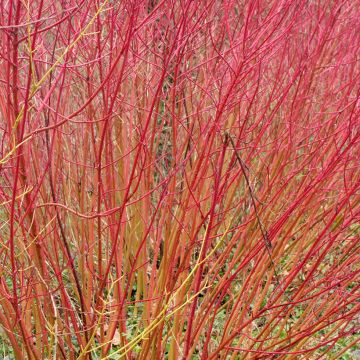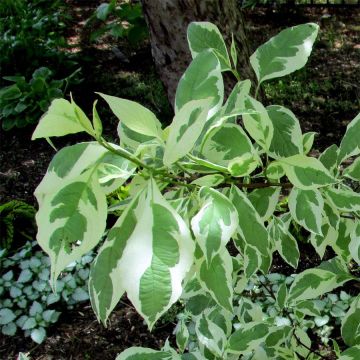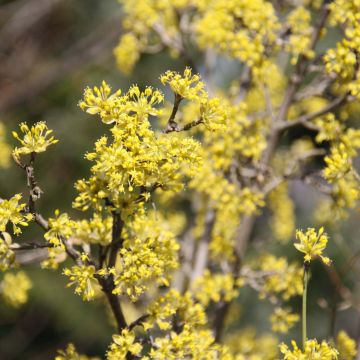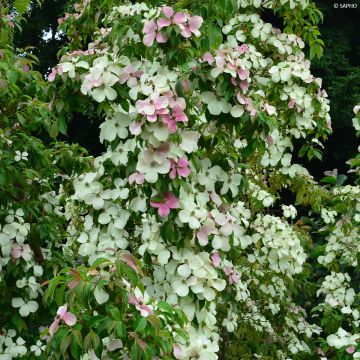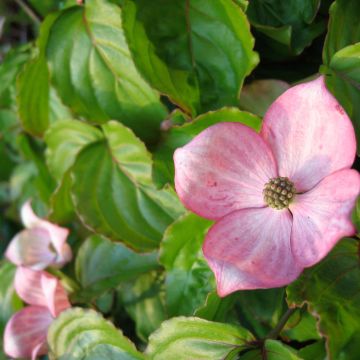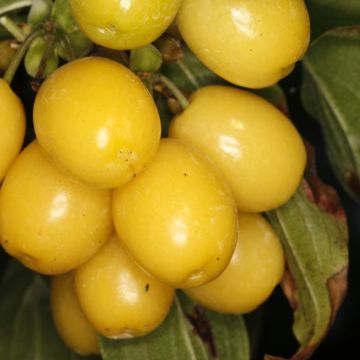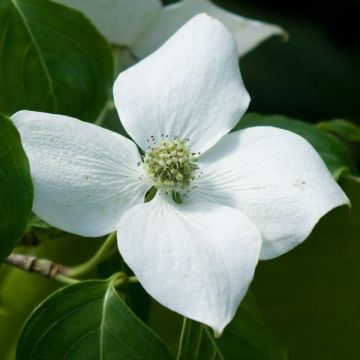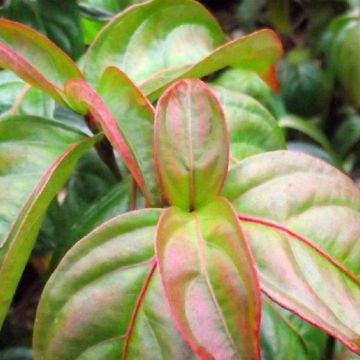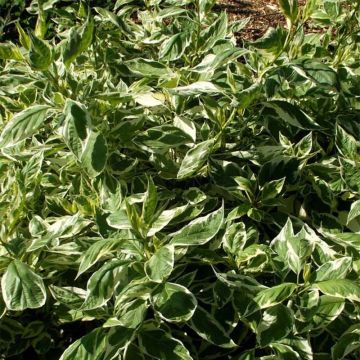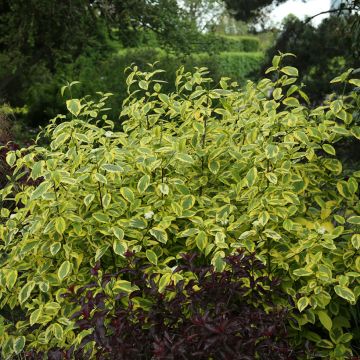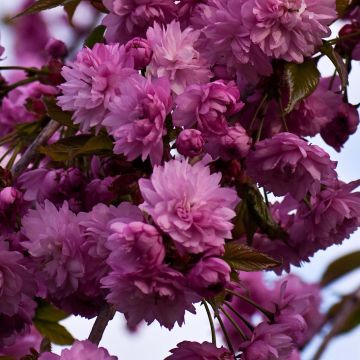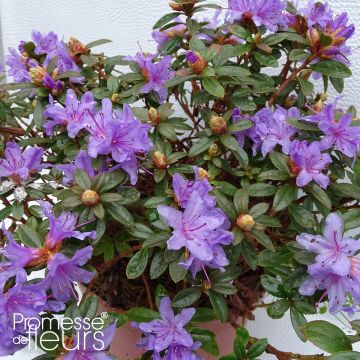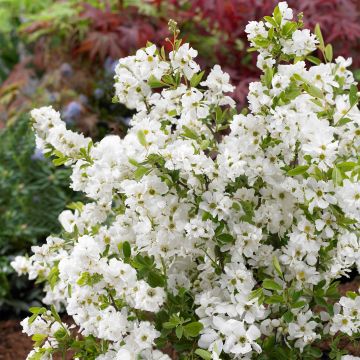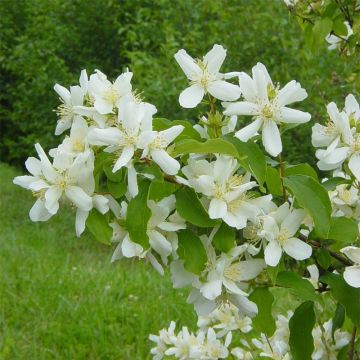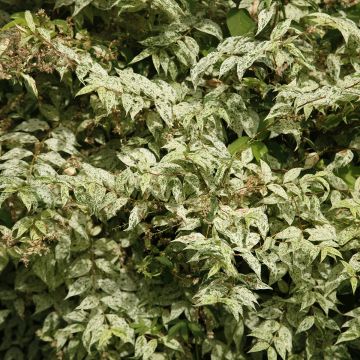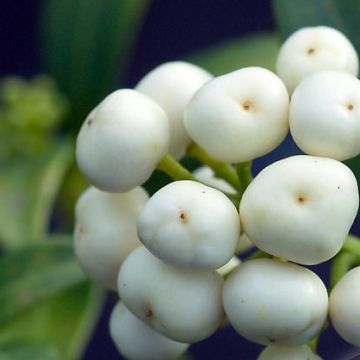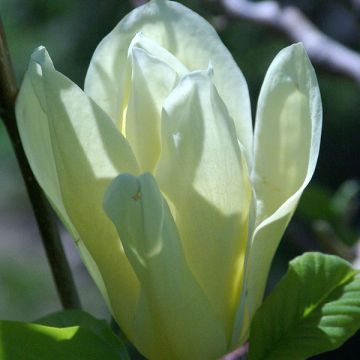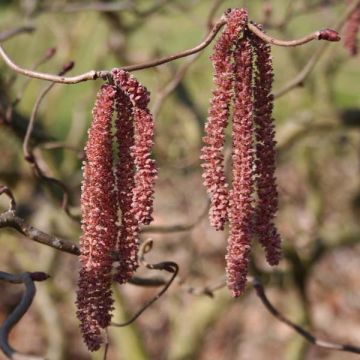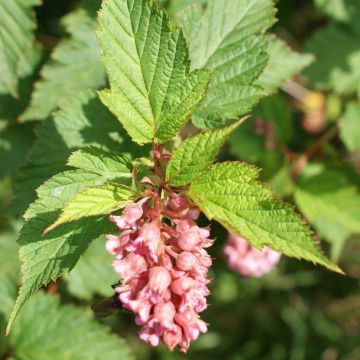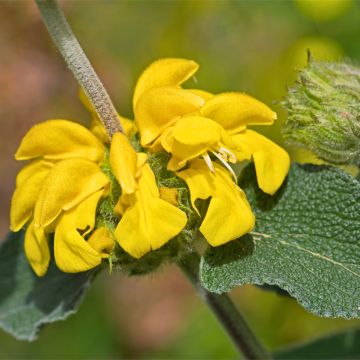

Cornus kousa Big Apple


Cornus kousa Big Apple
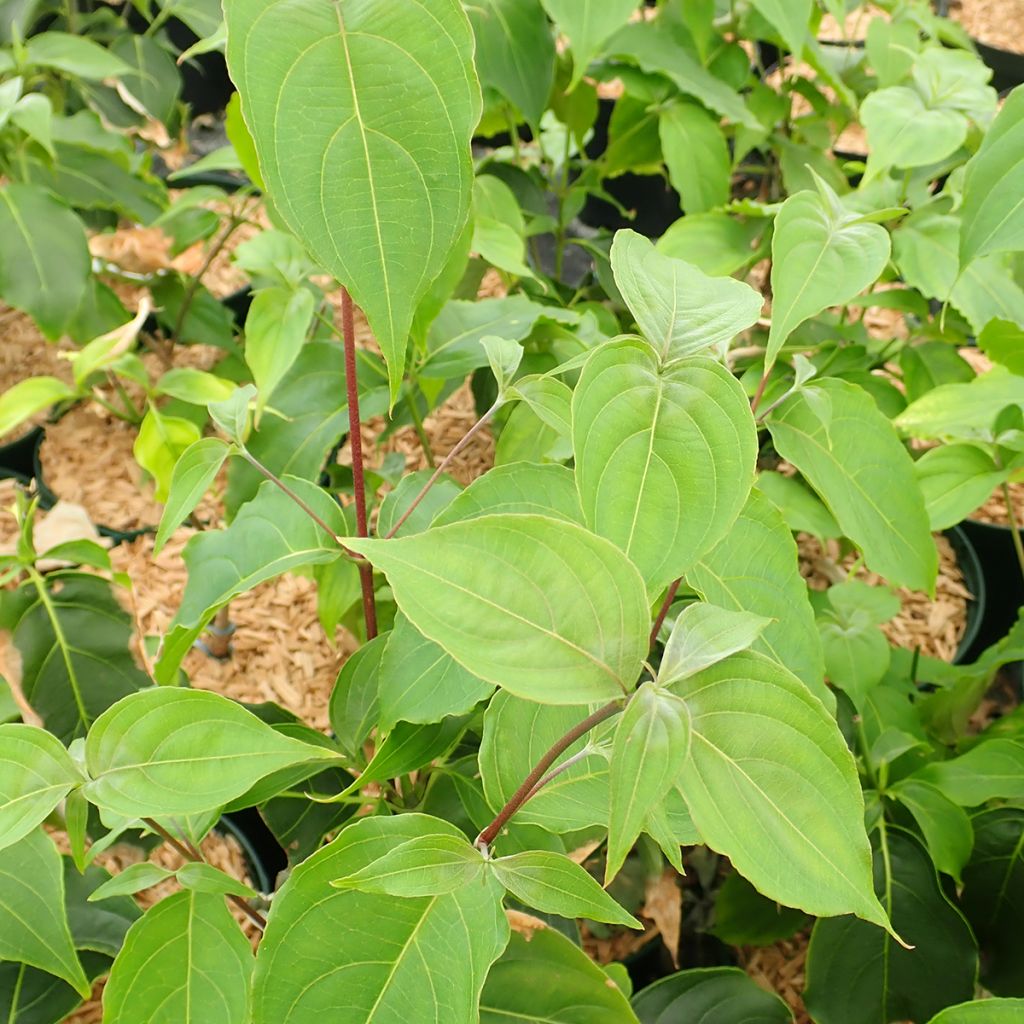

Cornus kousa Big Apple
Cornus kousa Big Apple
Cornus kousa Big Apple
Kousa Dogwood, Korean Dogwood, Chinese Dogwood, Japanese Dogwood
Why not try an alternative variety in stock?
View all →This plant carries a 24 months recovery warranty
More information
We guarantee the quality of our plants for a full growing cycle, and will replace at our expense any plant that fails to recover under normal climatic and planting conditions.
From €5.90 for pickup delivery and €6.90 for home delivery
Express home delivery from €8.90.
Does this plant fit my garden?
Set up your Plantfit profile →
Description
Cornus kousa 'Big Apple' (big apple) is a variety of Japanese Dogwood, named for the size of its fruits, which are significantly larger than those of other varieties. In spring, the bush dazzles with its immaculate white flowering that covers the foliage like a swarm of butterflies. In summer, the large pink-red fruits are also decorative and can be eaten. When autumn comes, the foliage provides a spectacular display of vibrant colours. It is a hardy dogwood that requires little maintenance. It just needs a neutral to acidic, moist soil, and a sunny to semi-shaded exposure.
Dogwoods belong to the botanical family Cornaceae. The Cornus genus includes several dozen species of deciduous or evergreen trees and shrubs, often ornamental. Cornus kousa (synonym Benthamia japonica) is native to Korea and Japan, where it is locally called Yamaboushi. This species is also found in northern India and up to Bhutan. In these countries, it forms large shrubs up to 6m high and even small trees up to 10m. It was introduced into our European parks and gardens around 1875.
'Big Apple' is a vigorous American selection, with a spreading silhouette as wide as it is tall, forming layers of vegetation. In ten years of planting, it generally reaches a height of 3m and the same in width, while at maturity, it can reach 5 or 6m in height and width. The elliptical leaves have a regular shape and measure about 10cm long and 5cm wide. They are a beautiful glossy dark green with clearly visible lighter veins. The habit is relatively flat, with layers that create the distinctive pattern of the bush. This dark vegetation is perfect for highlighting the clear flowering that appears towards the end of May. The inflorescences are about 10cm in diameter, composed of clusters of small true, green flowers surrounded by four wide and pointed bracts forming a star. These white bracts, sometimes mistaken for flowers, are transformed leaves. The abundant flowering covers the plant, creating a magnificent scene in June. This Dogwood is undoubtedly one of the most beautiful flowering shrubs in spring. Carried by peduncles that slightly elevate them above the foliage, the inflorescences resemble a colony of white butterflies that have chosen the bush to rest. The bracts persist for a few weeks after the pollination of the true flowers. After they fall, the true central flowers transform into fruits approximately 3cm in diameter, larger than those of other varieties. They are pink to red and round, bristling with small protuberances that correspond to the old flowers, they have a real decorative interest in summer. They are also edible, with a slightly sweet flesh (although they do not have a real taste appeal). Autumn marks a new ornamental episode for this Dogwood, which, under the effect of the first frosts, takes on a dazzling colours. Gradually, the green of the foliage gives way to a flaming orange-red, once again placing this shrub in the list of the best autumn colours in the garden. The deciduous leaves eventually fall to the ground, forming a decorative carpet until the first gust of wind...
The 'Big Apple' Dogwood deserves its place in the garden, either as a specimen on a lawn or integrated into a diverse flowerbed, in the background. Plant the beautiful Chinese Azalea 'Homebush' at its feet, which will reward you with its clusters of small pink star-shaped flowers in April-May. To extend the flowering period into summer, choose one of the many Hydrangeas available, rich in various forms and colours. For autumn, nothing beats a few plants of Camellia sasanqua for your flowerbed, and to complete the circle, consider adding a Hamamelis vernalis 'Washington Park', whose filamentous purple flowers will amaze you from January to March. A garden in bloom all year round is possible if you choose your shrubs wisely!
Report an error about the product description
Plant habit
Flowering
Foliage
Botanical data
Cornus
kousa
Big Apple
Cornaceae
Kousa Dogwood, Korean Dogwood, Chinese Dogwood, Japanese Dogwood
Cornus florida Big Apple
Cultivar or hybrid
Other Cornus
Planting and care
Cornus Kousa originates from Japan, Korea, and China and will thrive in continental climates and temperate zones. However, extremely cold temperatures can cause a lack or reduction in flowering. Nevertheless, this bush is very hardy and can withstand frost of at least -20°C. It tolerates sunny exposures in areas with moderately hot summers. In hot regions, it should be planted away from the scorching sun.
Cornus kousa 'Big Apple' prefers fertile, well-drained, and slightly acidic soils. It can tolerate clay soils as long as it is protected from excessive moisture, especially in winter. Plant it in a deep hole lined with clay balls, coarse sand, or gravel to ensure good drainage. At planting, add compost and ericaceous soil, mixing them with the existing soil. Mulching with pine bark will help maintain soil moisture and acidity. This rare Cornus grows well once it has been properly planted.
Water regularly during the first two years of planting. Once the bush is established, water should only be provided in case of drought.
Pruning is not essential but can be done at the end of winter to remove diseased or dead wood and crossing branches to maintain an attractive shape.
It is resistant to diseases and low-maintenance, it will look after itself and still look beautiful!
Planting period
Intended location
Care
This item has not been reviewed yet - be the first to leave a review about it.
Spring-flowering shrubs
Haven't found what you were looking for?
Hardiness is the lowest winter temperature a plant can endure without suffering serious damage or even dying. However, hardiness is affected by location (a sheltered area, such as a patio), protection (winter cover) and soil type (hardiness is improved by well-drained soil).

Photo Sharing Terms & Conditions
In order to encourage gardeners to interact and share their experiences, Promesse de fleurs offers various media enabling content to be uploaded onto its Site - in particular via the ‘Photo sharing’ module.
The User agrees to refrain from:
- Posting any content that is illegal, prejudicial, insulting, racist, inciteful to hatred, revisionist, contrary to public decency, that infringes on privacy or on the privacy rights of third parties, in particular the publicity rights of persons and goods, intellectual property rights, or the right to privacy.
- Submitting content on behalf of a third party;
- Impersonate the identity of a third party and/or publish any personal information about a third party;
In general, the User undertakes to refrain from any unethical behaviour.
All Content (in particular text, comments, files, images, photos, videos, creative works, etc.), which may be subject to property or intellectual property rights, image or other private rights, shall remain the property of the User, subject to the limited rights granted by the terms of the licence granted by Promesse de fleurs as stated below. Users are at liberty to publish or not to publish such Content on the Site, notably via the ‘Photo Sharing’ facility, and accept that this Content shall be made public and freely accessible, notably on the Internet.
Users further acknowledge, undertake to have ,and guarantee that they hold all necessary rights and permissions to publish such material on the Site, in particular with regard to the legislation in force pertaining to any privacy, property, intellectual property, image, or contractual rights, or rights of any other nature. By publishing such Content on the Site, Users acknowledge accepting full liability as publishers of the Content within the meaning of the law, and grant Promesse de fleurs, free of charge, an inclusive, worldwide licence for the said Content for the entire duration of its publication, including all reproduction, representation, up/downloading, displaying, performing, transmission, and storage rights.
Users also grant permission for their name to be linked to the Content and accept that this link may not always be made available.
By engaging in posting material, Users consent to their Content becoming automatically accessible on the Internet, in particular on other sites and/or blogs and/or web pages of the Promesse de fleurs site, including in particular social pages and the Promesse de fleurs catalogue.
Users may secure the removal of entrusted content free of charge by issuing a simple request via our contact form.
The flowering period indicated on our website applies to countries and regions located in USDA zone 8 (France, the United Kingdom, Ireland, the Netherlands, etc.)
It will vary according to where you live:
- In zones 9 to 10 (Italy, Spain, Greece, etc.), flowering will occur about 2 to 4 weeks earlier.
- In zones 6 to 7 (Germany, Poland, Slovenia, and lower mountainous regions), flowering will be delayed by 2 to 3 weeks.
- In zone 5 (Central Europe, Scandinavia), blooming will be delayed by 3 to 5 weeks.
In temperate climates, pruning of spring-flowering shrubs (forsythia, spireas, etc.) should be done just after flowering.
Pruning of summer-flowering shrubs (Indian Lilac, Perovskia, etc.) can be done in winter or spring.
In cold regions as well as with frost-sensitive plants, avoid pruning too early when severe frosts may still occur.
The planting period indicated on our website applies to countries and regions located in USDA zone 8 (France, United Kingdom, Ireland, Netherlands).
It will vary according to where you live:
- In Mediterranean zones (Marseille, Madrid, Milan, etc.), autumn and winter are the best planting periods.
- In continental zones (Strasbourg, Munich, Vienna, etc.), delay planting by 2 to 3 weeks in spring and bring it forward by 2 to 4 weeks in autumn.
- In mountainous regions (the Alps, Pyrenees, Carpathians, etc.), it is best to plant in late spring (May-June) or late summer (August-September).
The harvesting period indicated on our website applies to countries and regions in USDA zone 8 (France, England, Ireland, the Netherlands).
In colder areas (Scandinavia, Poland, Austria...) fruit and vegetable harvests are likely to be delayed by 3-4 weeks.
In warmer areas (Italy, Spain, Greece, etc.), harvesting will probably take place earlier, depending on weather conditions.
The sowing periods indicated on our website apply to countries and regions within USDA Zone 8 (France, UK, Ireland, Netherlands).
In colder areas (Scandinavia, Poland, Austria...), delay any outdoor sowing by 3-4 weeks, or sow under glass.
In warmer climes (Italy, Spain, Greece, etc.), bring outdoor sowing forward by a few weeks.

































